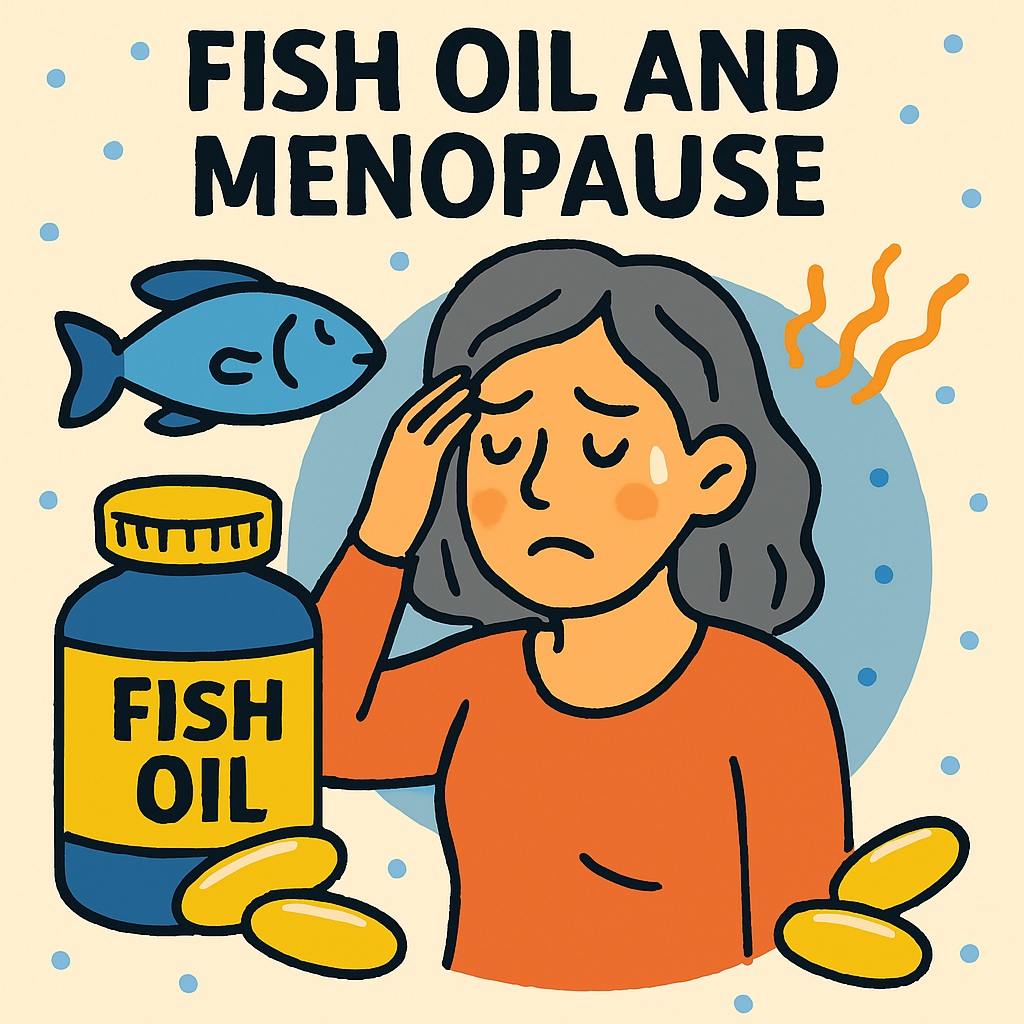
What can fish oil really do during menopause? Which effects are supported by science, and what does the latest research say? This article provides a full breakdown.
 What Is Fish Oil and Why Does It Matter in Menopause?
What Is Fish Oil and Why Does It Matter in Menopause?
Fish oil is a natural fat extracted from deep-sea fish such as salmon, mackerel, and sardines. It contains two essential Omega-3 fatty acids:
-
EPA (Eicosapentaenoic acid) – supports cardiovascular health and emotional balance
-
DHA (Docosahexaenoic acid) – supports brain function, skin health, and cognition
Both compounds play important roles in physiological systems and have proven potential in addressing key menopausal symptoms.
 Five Core Benefits of Fish Oil for Menopausal Women
Five Core Benefits of Fish Oil for Menopausal Women
1. Alleviates Mood Swings and “Brain Fog”
-
Hormonal changes during menopause can disrupt neurotransmitters like serotonin and dopamine, leading to anxiety, irritability, mild depression, and memory issues.
-
A 2025 narrative review (PubMed ID: 40444522) confirmed EPA and DHA’s role in improving emotional stability and cognitive clarity.
-
Data from the SWAN study (n=3053) also showed a negative correlation between Omega-3 intake and depressive symptoms in perimenopausal women [1][2].
2. Protects Cardiovascular Health
-
As estrogen declines, women become more prone to dyslipidemia and cardiovascular disease.
-
Fish oil lowers triglycerides, reduces inflammation, and improves arterial elasticity. Some studies show it may also raise HDL (“good”) cholesterol [3][4].
-
The American Heart Association recommends ≥1 g/day of EPA+DHA for individuals at risk of cardiovascular disease.
3. May Relieve Hot Flashes and Night Sweats
-
Research is mixed: the large MsFLASH trial found no significant relief, but a smaller trial by Lucas et al. (n≈91) found that EPA reduced hot flash frequency and severity.
-
Conclusion: fish oil may provide mild relief but should not replace hormone therapy. It’s better used as a complementary approach [5][6].
4. Supports Bone Density and Joint Health
-
Fish oil helps regulate bone metabolism and may reduce bone loss; it also has anti-inflammatory effects beneficial to joint health.
-
Meta-analyses have found a positive association between DHA intake and bone mineral density, especially in postmenopausal women [7][8].
5. Improves Skin Dryness and May Support Sleep
-
DHA strengthens the skin barrier and may slow aging, which is why it is often included in skin-support supplements [9].
-
Early studies suggest fish oil may enhance sleep quality by reducing inflammation and supporting melatonin regulation [10].
 Dosage Recommendations and Usage Tips
Dosage Recommendations and Usage Tips
|
Category |
Recommendation |
|---|---|
|
General wellness |
500–1000 mg EPA+DHA daily |
|
For symptoms or heart health |
1500–2000 mg/day under medical supervision |
|
Maximum safe dose |
Up to 3000 mg/day (FDA upper limit) |
|
How to take it |
With meals (especially with fats) for better absorption |
|
With other nutrients |
Combine with calcium, vitamin D, magnesium, and phytoestrogens for synergistic effect |
 Notes and Precautions
Notes and Precautions
-
Fish oil is a dietary supplement, not a replacement for hormone therapy or prescription medication.
-
Choose high-purity, low-contaminant brands, preferably those tested for heavy metals (e.g., IFOS-certified).
-
Some people may experience mild side effects such as fishy aftertaste or bloating—opt for “odorless” capsules if needed.
-
Avoid high doses if you have a bleeding disorder, are on blood thinners, or preparing for surgery—consult a physician first.
 Conclusion: Embrace the Transition with Science-Backed Support
Conclusion: Embrace the Transition with Science-Backed Support
Menopause is not the end—it’s a transformation. Scientific evidence supports that supplementing with high-quality fish oil can help improve mood, protect the heart, support cognitive clarity, and maintain joint and bone health.
With the right diet, lifestyle, mindset, and nutritional support, you can navigate this new phase of life with calm, confidence, and grace.
 References
References
[1] Freeman, M. P., et al. (2006). Omega-3 fatty acids in psychiatry. J Clin Psychiatry, 67(12), 1954–1967.
[2] SWAN Study (2024), summary via PMC: https://pmc.ncbi.nlm.nih.gov/
[3] Mozaffarian, D., & Wu, J. H. (2011). Omega-3s and cardiovascular risk. JACC, 58(20), 2047–2067.
[4] American Heart Association: https://www.heart.org
[5] Lucas, M. et al. (2009). EPA for vasomotor symptoms. Menopause, 16(2), 357–365.
[6] MsFLASH Trials, via NIH/PMC summaries
[7] Kruger, M. C., et al. (2010). Omega-3 and bone health. Int J Endocrinol
[8] Weiler, H. A., et al. (2012). PUFAs in osteoporosis prevention. Nutr Rev, 70(10), 572–589
[9] Pilkington, S. M., et al. (2011). Omega-3 and skin aging. Exp Dermatol, 20(6), 537–543
[10] PubMed Review: https://pubmed.ncbi.nlm.nih.
Explore Supplements
Discover detailed information about dietary supplements and their ingredients.
Browse SupplementsMore Articles
Read more articles about nutrition, health, and dietary supplements.
Read More Articles